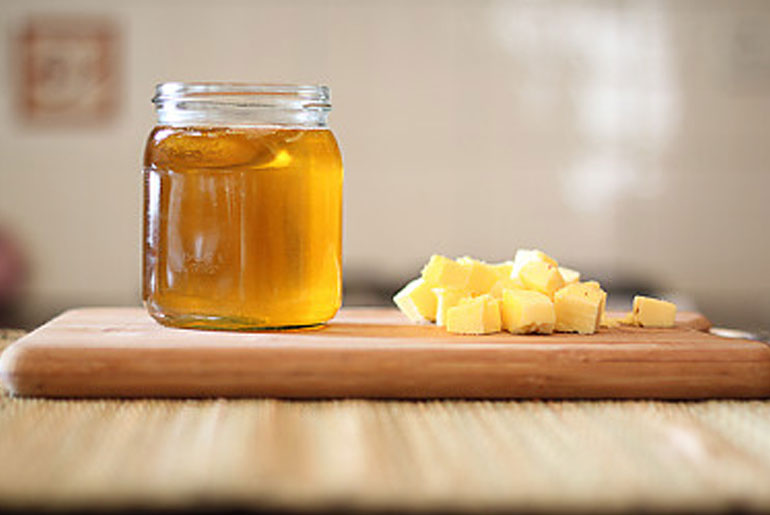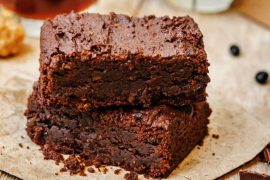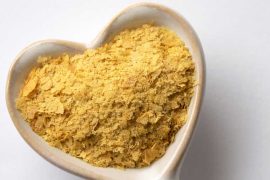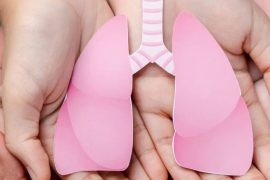Ghee
Ghee, a clarified butter with its origins deeply rooted in Ayurvedic traditions, offers a multitude of health benefits across various aspects of well-being. Nutritionally dense, ghee contains essential fat-soluble vitamins, aids in digestion, and possesses anti-inflammatory properties. It contributes to joint lubrication, supports mental clarity, and is recognized for its potential in wound healing and skincare. Furthermore, ghee extends its benefits to hair care, serving as a natural moisturizer, preventing damage, promoting hair growth, and enhancing shine. However, moderation is key, and high-quality, organic ghee is recommended to maximize its nutritional value. Whether incorporated into dietary practices or utilized externally, ghee stands as a versatile and transformative substance, promoting holistic health and wellness.
Properties of ghee:
Ghee is revered for its healing properties due to its rich nutrient profile, including fat-soluble vitamins A, D, and E. Its anti-inflammatory characteristics, attributed to butyric acid, may alleviate conditions linked to chronic inflammation. In Ayurvedic medicine, ghee is believed to balance digestion, support joint lubrication, and enhance mental clarity. Topically, ghee is utilized for wound healing and skincare, offering antimicrobial protection and moisturizing effects. Additionally, its potential benefits extend to hair care, acting as a natural conditioner and promoting healthier hair. While incorporating ghee into healing practices, moderation and the use of high-quality, organic varieties are recommended for optimal results. Consulting healthcare professionals for personalized guidance is advisable, considering individual health conditions and dietary needs.
Nutritional value of Ghee:
Indeed, ghee is a calorie-dense food, providing approximately 883 calories per 100 ml. It consists almost entirely of fat, with 99.8 grams of fat in the same serving size. The predominant type of fat in ghee is saturated fat. While ghee does not contain significant amounts of proteins, carbohydrates, sugar, or fiber, it is rich in essential fat-soluble vitamins, including vitamin A, vitamin E, and vitamin K. Notably, when sourced from grass-fed cows, ghee may contain higher levels of these vitamins. Additionally, ghee contains butyric acid, which is known for its potential anti-inflammatory and digestive health benefits. It’s essential to consume ghee in moderation due to its high calorie and saturated fat content, but its nutrient profile can offer certain health benefits when integrated into a balanced diet.
Uses of ghee for healing:
- Nutrient-Rich Boost: Ghee is rich in fat-soluble vitamins such as A, E, and D. These vitamins are essential for various bodily functions, including immune system support, skin health, and bone strength. Incorporating ghee into your diet can provide a natural and wholesome source of these nutrients.
- Digestive Aid: Ghee is known for its digestive properties. It contains butyric acid, which is believed to support a healthy digestive tract. Consuming ghee in moderation can help improve digestion, reduce inflammation in the gut, and promote a healthy balance of gut bacteria.
- Anti-Inflammatory Powerhouse: Ghee contains anti-inflammatory compounds that may help reduce inflammation in the body. Chronic inflammation is linked to various health issues, including arthritis and heart disease. Including ghee in your diet may contribute to an anti-inflammatory lifestyle.
- Boosting Mental Clarity: Ayurveda considers ghee as a brain tonic. The saturated fats in ghee are believed to support cognitive function and may help improve memory and concentration. It is often used in Ayurvedic practices to enhance mental clarity and promote overall brain health.
- Lubricating Joints: Ghee is said to have a lubricating effect on joints, which can be beneficial for those dealing with arthritis or joint pain. The healthy fats in ghee may contribute to joint flexibility and help alleviate stiffness.
- Supporting Weight Management: Contrary to common belief, moderate consumption of ghee can be a part of a healthy diet and may even support weight management. The healthy fats in ghee can help keep you satiated, reducing the likelihood of overeating.
- External Healing: Ghee is not only beneficial when consumed internally but can also be used externally. It is often applied topically to moisturize the skin, soothe burns, and promote wound healing. The nourishing properties of ghee make it a versatile addition to your skincare routine.
- Ghee in Ayurvedic Desserts: Use ghee in the preparation of Ayurvedic desserts and sweets. Ghee adds richness and flavor while aligning with Ayurvedic principles, making your indulgence a mindful and balanced treat.
Making ghee at home:
Making ghee at home is a simple and rewarding process. Here’s a step-by-step guide:
Ingredients:
- 2 cups of heavy cream
- 1 tablespoon of curd (yogurt)
Instructions:
Culturing the Cream:
- Take 2 cups of heavy cream and add 1 tablespoon of curd to it.
- Allow the mixture to sit at room temperature for about 7 to 8 hours. This process allows the cream to culture.
Refrigeration:
- Refrigerate the cultured cream for 5 to 6 hours. This helps in solidifying the cream.
Buttermilk Separation:
- After refrigeration, add cold water to the cream and blend it in a food processor until butter separates from the buttermilk.
- The resulting liquid is buttermilk, which can be used for various culinary purposes.
Butter Washing:
- Remove the separated butter and wash it well with cold water two or three times. This step ensures that any remaining buttermilk is washed away.
Heating the Butter:
- Place the washed butter in a heating pan.
- Heat the butter until it starts boiling. Stir occasionally to prevent sticking.
Evaporation and Clarification:
- As the butter boils, the liquid portion will gradually evaporate, and milk solids will settle at the bottom of the pan.
- The remaining golden yellow liquid is clarified butter, or ghee.
Straining:
- Allow the ghee to cool down a bit and then strain it using a fine mesh or cheesecloth to remove the milk solids completely.
Storage:
- Store the strained ghee in a closed container once it reaches room temperature.
Homemade ghee not only provides a rich, nutty flavor but also ensures the absence of additives or preservatives. It can be a healthier alternative to store-bought options, especially when made from high-quality ingredients.
Conclusion:
In conclusion, embracing the healing power of ghee is an invitation to tap into the rich heritage of ancient Indian tradition and holistic well-being. The diverse range of benefits, from digestive support to mental clarity, positions ghee as more than a culinary ingredient—it becomes a golden elixir for overall health. By seamlessly integrating ghee into daily life, one can draw from the wisdom of Ayurveda and experience the transformative potential of this revered substance. This journey toward holistic wellness invites individuals to appreciate the time-tested properties of ghee, fostering vitality and embracing a balanced approach to health and healing.
Disclaimer:
The information contained in this article is for educational and informational purposes only and is not intended as a health advice. We would ask you to consult a qualified professional or medical expert to gain additional knowledge before you choose to consume any product or perform any exercise.








